Selecting a good shotgun mic. In my book, there are only two professionally proven choices: Sennheiser or Audio Technica.
Sennheiser invented shotgun mics and has been the Hollywood standard for decades. Their most popular short shotgun offerings are the Sennheiser K6/ME66 and the MKH60. The ME66 is an electret condenser type of mic, very popular for lower budget applications, and is around $450. It operates from an internal AA battery or from external Phantom power (only found on higher end prosumer camcorders or portable audio mixers). The MKH60 is a full condenser mic and only operates from 48v Phantom power. It is very popular on feature film sets and is way more sensitive than the ME66. It is also way more expensive, around $1500.
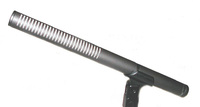 Audio Technica is an alternative. They make fantastic microphones and are also extremely popular in Hollywood circles. What I like the most about Audio Technica is their affordability (without compromising quality) and their exceptional customer support. The AT897 (seen left) is comparable to the ME66, yet only sells for $250 (including the foam windscreen). It works off of an AA battery, or can use Phantom power. The BP4073a is a full condenser mic, and only operates from Phantom power. Price is in the low $500's.
Audio Technica is an alternative. They make fantastic microphones and are also extremely popular in Hollywood circles. What I like the most about Audio Technica is their affordability (without compromising quality) and their exceptional customer support. The AT897 (seen left) is comparable to the ME66, yet only sells for $250 (including the foam windscreen). It works off of an AA battery, or can use Phantom power. The BP4073a is a full condenser mic, and only operates from Phantom power. Price is in the low $500's.
Personally, I find that the AT897 outperforms the more expensive ME66 both in terms of strong front reach as well as overall sound quality (fullness). It is definitely a first choice for most video production classes.
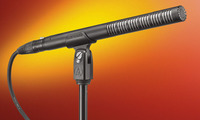 The BP4073a (seen right) is absolutely top notch, but is a little more expensive (yet far less costly than the MKH60) than the simpler mics. It would be my choice for elite student projects or faculty produced works; but not for the majority of students.
The BP4073a (seen right) is absolutely top notch, but is a little more expensive (yet far less costly than the MKH60) than the simpler mics. It would be my choice for elite student projects or faculty produced works; but not for the majority of students.
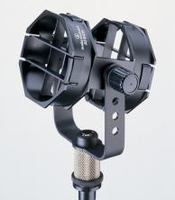 To mount a shotgun mic onto a boompole requires a device to not only hold the mic but to insulate it from vibration and handling noise. We call these "shockmounts."
To mount a shotgun mic onto a boompole requires a device to not only hold the mic but to insulate it from vibration and handling noise. We call these "shockmounts."
Two of the industry's favorite shockmounts are the Audio Technica AT8415 "universal" shockmount (and the K-Tek K-SM.
The AT8415 (seen left) features criss-crossed "rubber" mic bands and sells for under $60.
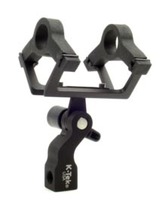 The K-SM (seen right) uses a molded inverted "V" arrangement and sells for $135. The K-Tek is a little more student friendly since they do not have to master the art of over-under-ing the bands; but the AT8415 is around half the price.
The K-SM (seen right) uses a molded inverted "V" arrangement and sells for $135. The K-Tek is a little more student friendly since they do not have to master the art of over-under-ing the bands; but the AT8415 is around half the price.
Audio Technica also offers a brass camera shoe adapter (the AT8469 Camera Mount Adapter, seen left) that allows you to mount either shockmount to a camcorder.
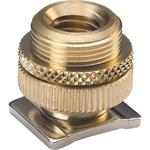 With some quick modifications (as seen to the right), you can make it even tighter and more efficient by following the steps:
With some quick modifications (as seen to the right), you can make it even tighter and more efficient by following the steps:
A useful trick (see right) for making the standard 5/8 adapters more field worthy is to insert a 3/8-16 set screw into the threaded opening in the 5/8 portion of the adapter. Use some thread adhesive or glue to secure it. Then add a small rubber washer where the shaft of the 3/8 screw protrudes from the body of the 5/8 shaft. Finally, slip a rubber O-ring over the entire piece so it rests below the lockdown nut.
 Now, when you attach your 3/8 shockmount to the camcorder, it will fit directly onto the 3/8 to camera shoe adapter and no longer require the removable 3/8 to 5/8 adapter. The friction of the rubber washer will allow you to quickly align the shockmount so that the mic is pointed directly forward (without wrestling with metal friction nuts that never seem to lock down precisely). And the O-ring fills any gaps between the lockdown nut and the camera shoe.
Now, when you attach your 3/8 shockmount to the camcorder, it will fit directly onto the 3/8 to camera shoe adapter and no longer require the removable 3/8 to 5/8 adapter. The friction of the rubber washer will allow you to quickly align the shockmount so that the mic is pointed directly forward (without wrestling with metal friction nuts that never seem to lock down precisely). And the O-ring fills any gaps between the lockdown nut and the camera shoe.
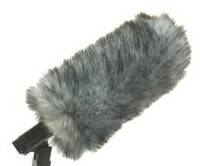 One more important item to add to your inventory is a furry windscreen for outdoor use.
One more important item to add to your inventory is a furry windscreen for outdoor use.
Indoors, the standard foam windcreen (that comes with most mics) is sufficient. By the way, always use a windscreen because even the simple act of booming creates moving air against the mic. In addition, the foam windscreen acts as a protective pad in the event that the mic strikes a hard surface such as a wall, ceiling, or (gulp!) the floor!
Outside, though, the basic foam windscreen will do very little as far as blocking the wind from striking the microphone. K-Tek and Rycote both manufacture affordable "furry" windscreens that consist of acoustic foam surrounded by fake fur. The furry texture breaks up the wind and reduces resistance that could cause acoustic noise from air flowing across the surface.
I vote for the K-Tek Z-FSO-S ($110) for either the Audio Technica AT897 or the AT4073a. They are built right here in the good ole USA by good people and I like that. Good product, good customer support, and we can keep the bucks on our side of the ocean.
